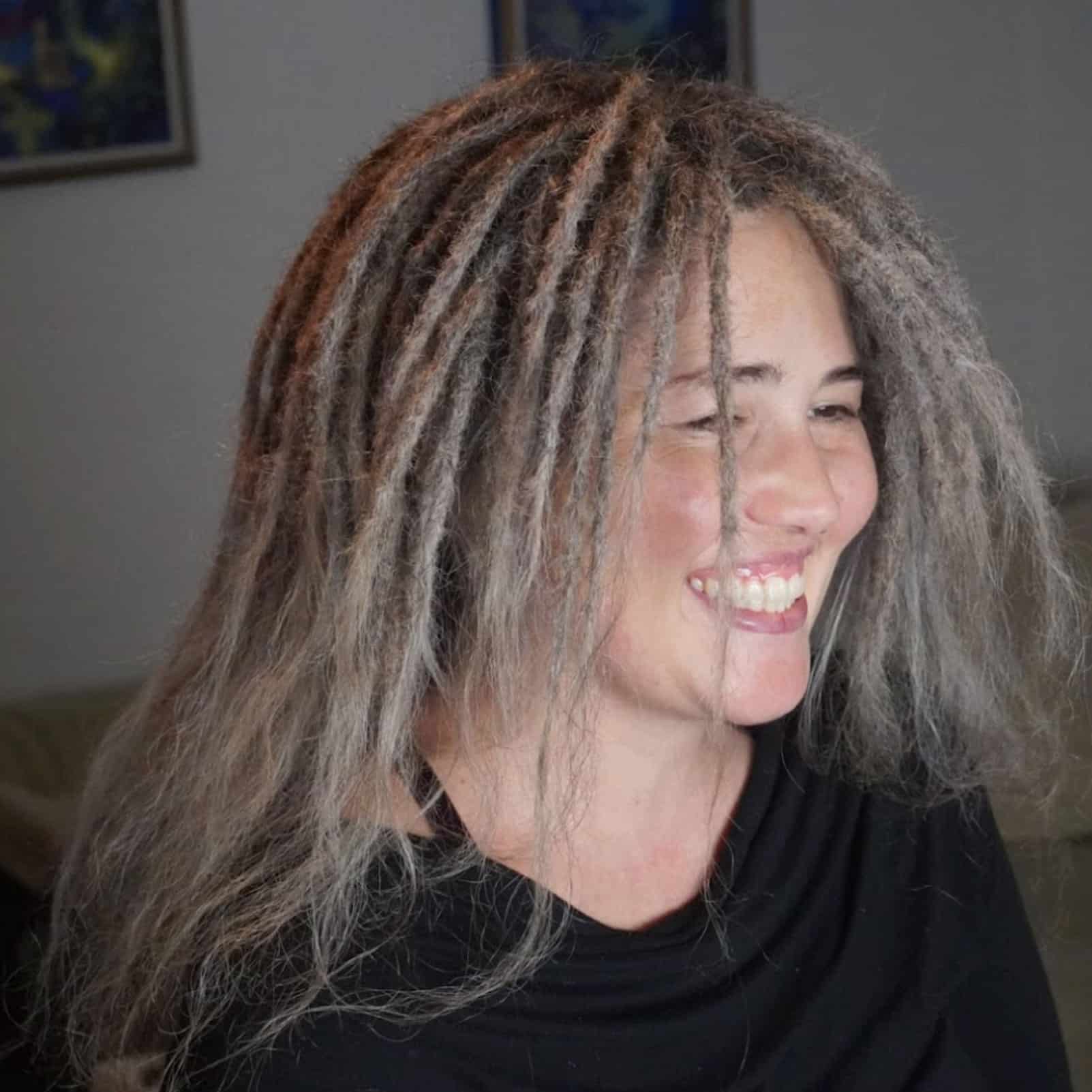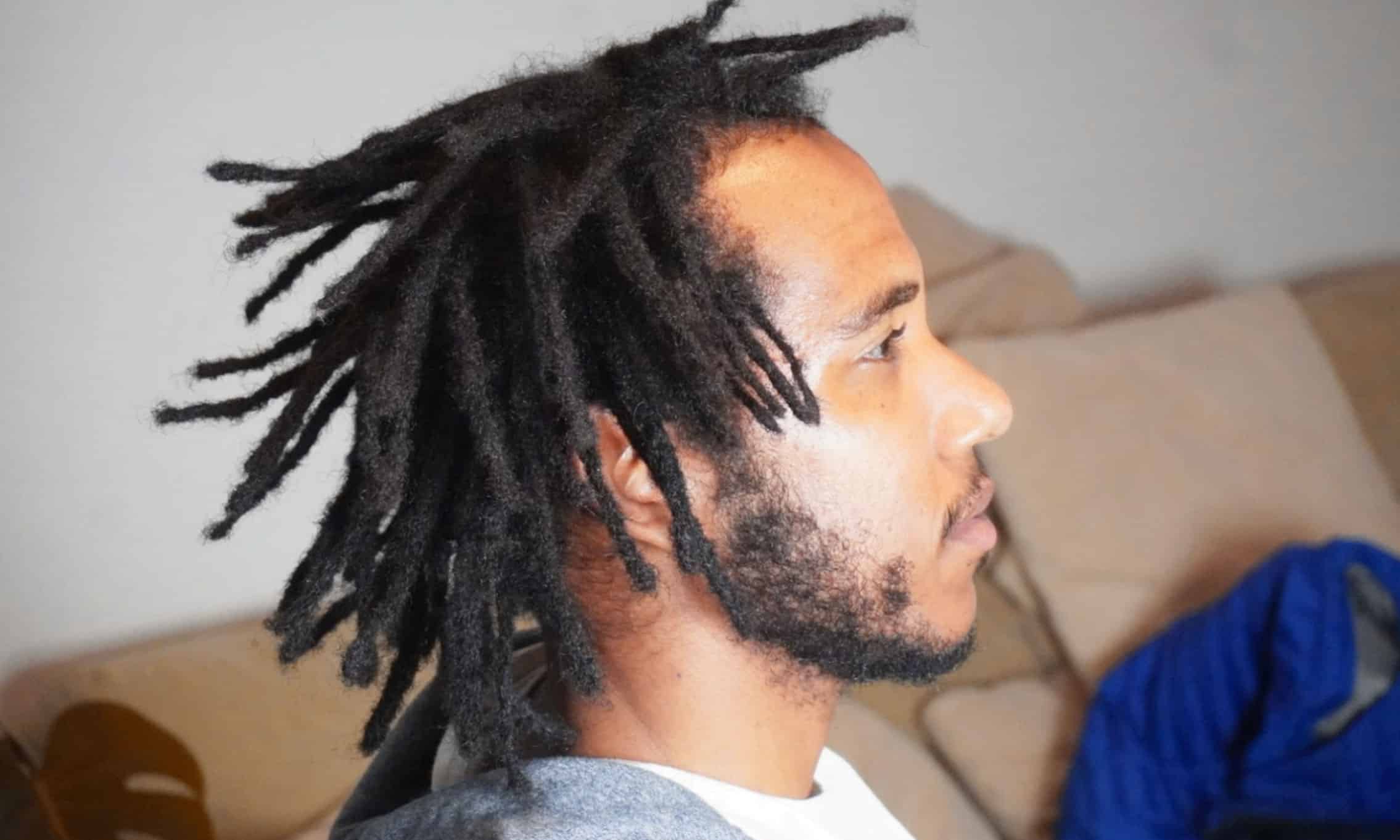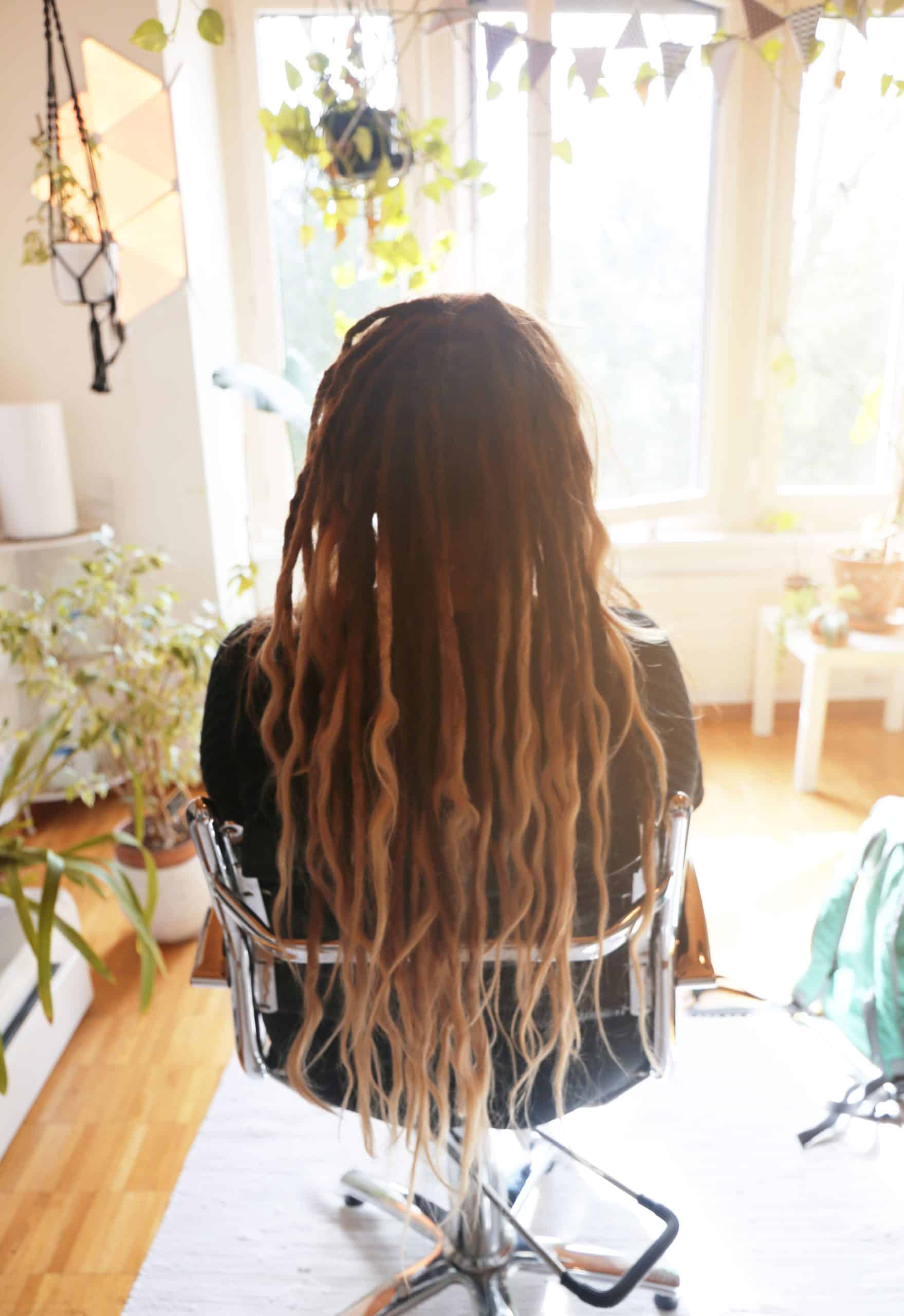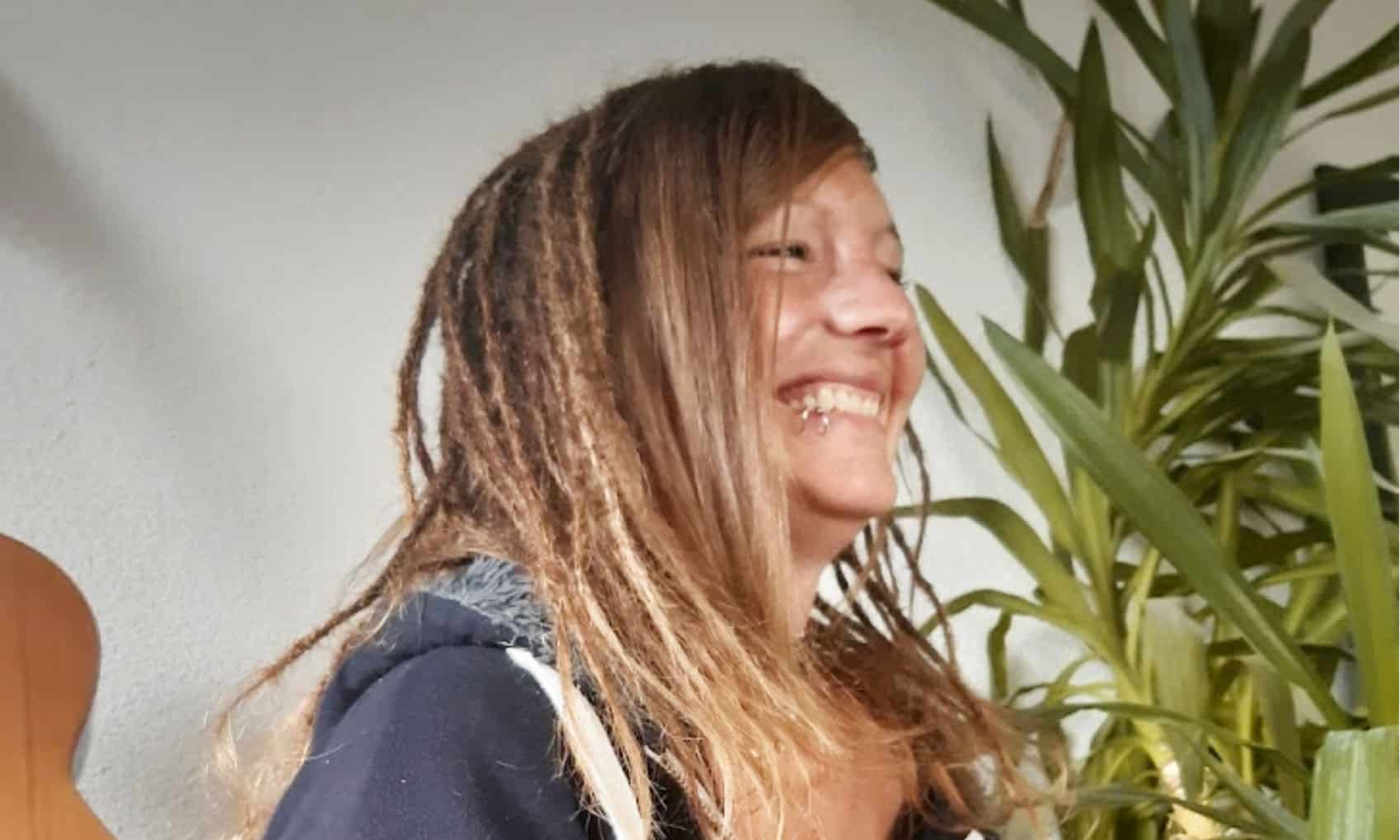Make the whole head dreadlocks
Are you ready to get your whole head full of dreadlocks?
Making your whole head dreadlocks is a commitment and you need patience. Therefore, it is important that you get well informed and take your time in making the decision. That’s why you‘ve come to the right placehere at Dreadlocks Artesanal .

- Why is it a commitment?
- Are my dreadlocks getting shorter?
- Care for new dreadlocks
- How does it take to make new dreadlocks?
- The dreadlocks techniques
- Are there different techniques for African hair than for Caucasian hair?
- What we want to know from you before your dreadlocks
- How do you prepare for the appointment?
Requirements for new dreads
Our technique works with all hair types, as long as your hair is at least 17 cm long (or better: even longer).
Why is it a Commitment?
New dreadlocks are an aesthetic transformation! You will look different afterwards and also have a different effect on people. Doing dreadlocks is not like going to a coiffeur or hairdresser. There, you’ll look your best when you walk out of the store freshly styled.
It’s a little different for us. When you come to us to get your dreads done, it’s the start or rather the birth of your baby dreads. The baby dread analogy works on several levels. With children, you can’t exactly wish for what they look like either. They are never exactly perfect, but they are still beautiful. Secondly, baby dreads don’t look as great as adult dreads in the beginning because it takes time and care. More information on this below.
Are my Dreadlocks getting shorter?
You should be aware that your dreadlocks will be a third to a half shorter than your normal hair in the beginning. It is a good moment to familiarize yourself with this thought.
Care for new Dreadlocks
Especially in the beginning it is important to give the baby dreadlocks the care they need. This is particularly time-consuming at the beginning. You will be able to maintain your own dreads after visiting us, but it takes a lot of patience and time. On the other hand, if you want to have your dreads re-crocheted by someone, you need to be aware that it will come at an additional cost.
How does it take to make new Dreadlocks?
It takes us between 8 and 20 hours to twist the whole head. We try to work in teams when possible so we can complete your dreadies in one day. If no team is available, then sometimes it takes two sessions.
Check out our calculator to get an idea of how long it takes
The Dreadlocks Techniques
There are several techniques on how to make dreadlocks.
Crochet (our technique)
We felt your hair with the crochet hooks. This is a very efficient technique, which leads to an optimal result. We also use the Crochet for repairs and maintenance.
It is good to know that many Dreader:innen work with the Crochet. Nevertheless, even if the same tool is used, there are different styles and techniques. Some use the Crochet differently than we do and are therefore faster, but the dreads are not as compact as when we do it. Therefore, working with the Crochet does not mean working with the Crochet.
Backcombing (not recommended)
In this technique, a strand of hair is tousled by means of a comb and thus matted. After that often crochet dreads and / or rolled in the palms. The latter is called “palm rolling”.
What we find problematic about backcombing is that during the tuping process, the hair is pushed towards the head. The dreadlock is therefore much thicker at a certain length than it naturally grows back afterwards. The Crochet method succeeds in twisting the strand of hair regularly along its length so that no thickening occurs.
Are there different techniques for African hair than for Caucasian hair?
Our method works with all hair types as long as they are long enough. Different techniques are used in Afroshops. Often they work with wax and threads. We do not recommend these techniques, at least for Caucasian hair.

What we want to know from you before your dreadlocks
Before the appointment, we each have a few questions for you to get a little better sense of what your hopes and expectations are.
Thickness of your dreadlocks: classification and number
Regular, professionally prepared scheduling is important to us. This guarantees that the dreadlocks all become about the same thickness. We divide your head into small squares. The larger the base of a dreadlock, the thicker the dreadlock and the fewer the dreads.
As I said, the dreadlocks are not a hairstyle that you can choose from the catalog. People are all different. Density of the hair and the size of the head (and the division) will determine how many dreads will be created. Some customers want dreadlocks as thick as a pen, a carrot or a chalk. Unfortunately, we can’t do it exactly that way. Likewise, when people show pictures, we can only take the idea. We cannot reproduce it exactly. It’s a bit like having children: you never know exactly what the children will look like.
Thickness categories
- Rather thin: that gives between 70 and 90 dreadlocks. We usually make rather thin dreadlocks.
- Medium thick: Between 40 and 60 dreadlocks
- Extra thin: 100 to 130. If you want extra thin, you should let us know early enough. The effort required for this is considerably greater.
Dreadlocks should not be too thin, because otherwise they will break. Likewise, we personally do not like too thick dreads either. Among other things, because afterwards they can not be repaired so well with the Crochet method.
However, it should be said at this point that if your goal is to have dreadlocks up to the back of your knees in ten years, then we recommend medium dreadlocks. Medium dreadlocks have more material and therefore break less. If you want more of a filigree style, and you are also satisfied if the dreads “only” go up to your butt, then we recommend rather thin dreads.
Sometimes there are requests for the pattern of division, for example, that instead of squares, honeycombs. Or it is desired that the lines do not run along the vertex. Since a very good division is important to us and the above-mentioned requests bring technical problems (the division does not open), we unfortunately do not want to respond to them.
Tips: open or closed?
Closed tips have a blunt end.
Open tips run out at the bottom, almost like a brush. In other words, at the end of the dread, the hair is not dreaded.
Closed Tips
- Grow faster
- Are shorter at the beginning
- Take longer to create
- Take longer to repair

Open Tips
- Grow slower
- Are longer at the beginning
- Take less time to create
- Take less time to repair

It is important for you to know that the decision whether the tips are open or closed is not set in stone. Open dreadlocks can be closed, closed dreadlocks open every now and then.
The reason why the closed dreadlocks grow faster than the open ones is as follows: the open dreadlocks tend to erode at the ends. Closed dreads are more like rope with a rubber cap over the ends and therefore do not stretch out.
People with short hair, we therefore recommend to close the tips. For customers with longer hair, the decision is more aesthetic.

Leave fringes open?
Something you can also consider is if you want to leave the front part of your head, the fringe, open. Certain clients and customers appreciate this stylistic element.
Here is also true, it is easy to make additional dreads than to remove existing dreadlocks again.

Photos of other dread heads
Sometimes customers bring photos of other dread-heads. This helps us to get an idea, depending on the case. We cannot duplicate a dread head. Partially, the dreads in the photos are all different thicknesses, as they may be Natural dreads, which may still have “S-curves”.
Therefore, it is important for us that you come with an open mind and surrender to the process with as little bias as possible.
How do you prepare for the appointment?
Our first request: do not wash your hair 72 hours before the appointment.
Our second request concerns what you wash your hair with beforehand. Because the way you prepare for the appointment, you’re contributing to how fast we are and how well you can go on the journey with your new dreadies.
As soon as you have the appointment (or even before), why not buy curd soap and wash your hair only with it. It makes a huge difference for us. If you’ve been to the beach on vacation before and your hair is salted and sun bleached, that’s ideal too.
Well prepared hair felt much more efficient and sustainable, and it is easier to make the division.
The hair of customers who still wash it with shampoo (which includes organic shampoos) is silky and fine. They do not want to mat at all. The appointment takes longer and the result is not quite as satisfactory.
If you wash your hair with curd soap and then struggle with knots: Here we go! This is an excellent sign. Knots in the hair we call “embryo dreads”. It means that your hair is ready to become dreadies.
Advantages and disadvantages of a head full of dreadlocks
For the mountain goers:inside, the dreadlocks are like an extra cap and scarf, which provide extra warmth and protection in the harsh alpine winds. Sometimes I also tied the dreads under my chin.
If you ever travel to the tropical rainforest, you won’t like your dreadlocks very much. In a hot and humid climate, the dreadlocks are not so pleasant. Personally, I then have to hide them under a dreadlock cap. On the one hand so that they do not get stuck everywhere in the rainforest and my neck remains free. Otherwise, my head overheats.
Adult dreadlocks give less work than if you have long normal hair. Normal hair needs constant straightening to keep the hair from becoming dreads. Baby dreadlocks need a little more affection in the beginning. But after that you have less to do with your hair than before. The dreadlocks are also fixed in the morning. Hair tie in or knot, et voilà, the hairstyle for the day is ready.
Likewise, you are free to have your dreadlocks crocheted by yourself. If you are motivated enough to do this yourself, you won’t have hairdresser costs anymore.
With dreadlocks you stand out from the crowd. This can be positive, but also negative. Many dread-heads appreciate the effect of looking a little different. Nevertheless, it may also be that certain employers:inside are not so happy. In general, I feel that if you’re a dreadhead in the working world, you have to perform well so people don’t see your dreads. Anyway, I, as an elementary school teacher think it’s pretty cool that I’m standing there in the classroom with my dreads. And since I do my work solidly, no one cares about my hair. There is a tendency for the acceptance of a dreadlock hairstyle, whether it is the whole head or just in places, to increase greatly. Our customers work in all kinds of fields. That’s exactly how it should be, the accomplished performance counts, not the hairstyle on the head.
Or maybe not the whole head after all?
If you are not sure if you want to dread the whole head, you can also considerdreading only the top of the head(Top Head Dreads) or only the back of the head (Backhead Dreads) into dreadlocks.
The stages of dreadlocks: baby dreads to adulthood
The day we crochet your dreadlocks is the beginning. The birth of your baby dreadlocks, so to speak.
The dreadlocks go through a natural process. In the beginning, the dreads are still tousled, fuzzy, scratchy and, depending on their length, stand out from your head. In general, they are not so ready matted. Because, we can crochet around a dreadlock for as long as we want, it needs a natural matting process, which comes with time.
The baby dreadies then enter a phase of puberty. They get tousled, fuzzy, and don’t quite look the way you wanted them to. At this stage it is important that the dreadies are crocheted through from the base to the tip, so that they are once again well matted. We call this the education stitch. This can be done after only one month.
Depending on the type of hair and hair care, it takes several such stitches of education.
After that, the dreadlocks are grown up, which you no longer need to crochet the entire length; the base and tip are enough. Likewise, you need to re-crochet the dreadlocks less frequently: every 3 months to every 9 months is enough. There are also people who limit themselves to crochet I hair once a year.
How fast do the dreadlocks grow?
In the beginning, the dreadlocks do not grow so quickly. The reason is that the dreads still contract and mat. However, there comes a stage when your dreadlocks grow faster and eventually gain length even faster than a person with open hair who wants to grow the hair as long as possible.

Washing
How, with what and how often to wash dreadlocks?
These questions are very present for newcomers to Dreads. And often people are not completely satisfied with the answers they give me. Because, the washing routine depends on the individual people.
Beautiful dreadlocks generally do not like water. The water makes the dreadies get fuzzy, the tips open up, and at best S-curves form. Beautiful dreads like to be crocheted. So as a rule of thumb, if you wash your hair frequently, you should also re-crochet your dreadlocks more often.
How often do dreadlocks need to be washed?
How often someone wants to wash the dreads depends on several individual factors. On the one hand, different people have different hygiene needs. In this regard, it should be said that in our modern society we tend to overdo it with washing. For dreadlocks, once a week is actually a lot. Nevertheless, there are people who wash the dreads more often, others less often. At this point, however, it should also be mentioned that there is no such thing as perfect dreadlocks. Sometimes there are customers who wish that not a single hair sticks out of the dreadlocks, while they wash the dreads every 2 days. This is rather unrealistic.
How long should you wait to wash your hair, after the appointment? I always say it like this: if you feel the need to wash your hair immediately: go for it. Accordingly, you will have to start crocheting earlier.
With what to wash the hair before the appointment?
We recommend washing your hair with curd soap in preparation for the appointment. After the appointment, if you still have curd soap, still use it up. Otherwise, we recommend that you do a little trial and error yourself to see what works for you. Do not always use conditioner(for silky and shiny hair). Choose the soap or shampoo that is best for your scalp.
There is no need for special dreadlocks shampoos, they are rather overpriced. But if you like to try it, there’s nothing wrong with it.
Find your routine by testing a soap or shampoo over time. Stick with what works for you.
How to wash the dreads? The recommendations we make here are: 1) Lather the soap in your hand. 2) See that all soap is rinsed out well, otherwise residue may occur.
We are aware that many customers would like to have precise instructions on how often and with what they should wash their hair. But as I said, it really depends on the person and their hair. Simply putting any rules in the room would be unscientific and unprofessional on our part.
The main thing is to wash the scalp and rinse the soap thoroughly again. It is important that no soap residue remains! You can occasionally rinse your dreadlocks with just water.
Why do people want dreadlocks?
There are many different good reasons why people want to make dreadlocks. Over the many years that we’ve been doing dreadlocks, we’ve met a lot of people from a lot of different backgrounds. And so are the reasons why they decided to take the step of transformation.
Some do it for spiritual or religious reasons. Others because they like it and want to identify with a group. The Anders or the expression of an alternative thinking, is also sometimes expressed with dreadlocks. Social media serves as inspiration for people looking for transformation.
The meaning that the dreads have for someone grows and also changes over time. If you asked me a good 20 years ago why I wanted dreadlocks, the answer was much different than when you ask me today. There is no need to verbalize the reason. When you feel it that you want dreads, it is a good moment.
Is it even appropriate to dreadlock as a white person?
The discussion about cultural appropriation has not passed us by. I would just like to briefly state our view here. You can also read the interview in Blick with me.
It is in the nature of long hair that they become matted. When I say it is in nature, I mean the biochemical structure from which the individual hairs are built.
Matted hair strands have therefore appeared at the most diverse times, in the most diverse cultures on this planet. Not only that, but non-human animals also have dreadlocks when their fur gets long enough.
There is no culture that invented the dreadlocks. Therefore, wearing them is also not a cultural appropriation.
Nevertheless, the discussion of cultural appropriation and racism in general seems important and necessary. However, the fact that this culminates in dread-heads being sent off stage seems excessive to us and also harms the right causes that disadvantaged minorities bring forward.
As a dreadhead, knowing a little about the history of dreads is certainly not wrong.
Questions which come up again and again
Lice – Do I have to cut off my dreadlocks
No, you don’t have to cut off your dreadlocks if you have lice. Take a few deep breaths and read our blog article through or watch the video on YouTube.
If I don’t want the dreadlocks anymore, do I have to go bald?
Dreadlocks accompany us through our stages of life. And there comes a time when we want to let go. Many people cut off their dreads when a transformation is about to take place in their lives. Or simply when you no longer “feel” it.
If you don’t want the dreads anymore, you don’t have to go bald. It is best to let the dreads grow for a while without re-crocheting them. After that, you can cut them off, resulting in a short hairstyle. You can also shorten the dreads to a length of 10 to 20 cm and then “comb” them up using a thick needle. This will take a while and your hair will not be as thick at first as it was before the dread was created. Don’t worry, after a while it will all return to normal.
Will I be checked more often by the police with dreads?
As a dreadhead, you tend to be suspected of illegally consuming plants more often. The fact that the legislation in this regard is ignorant, arrogant, ridiculous and discriminatory does not need to be elaborated on here.
Fortunately, the laws have relaxed, at least in Switzerland. It’s already not like you’re constantly being nagged by the police. But statistically, you get checked a little more often.
Are you still unsure?
It’s important to us that you’re sure this is the right move for you. Of course, you can never be 100 percent and you are never 100 percent ready for such a transformation. A little doubt and nervousness are normal.
But if you’re really still unsure, we recommend that you still check out our Dread Your Head app.
Alternatively, you can just have a few individual dreadies made. Or possibly we’ll just make you some rows in the back of your mind.
We don’t want to “pimp” our service to anyone. Customer satisfaction is very important to us and it would be a pity for your money and our work if you had your dreads undone after a few weeks.
Reasons why you should do your dreadlocks with us
In the meantime, there are several Dreader:innen in Switzerland. When I started in 2008, Dreadlocks-Artesanal was the only address. Competition is good for business, so that’s a good thing.
More than 33 years of dreadlocks experience! That’s how much experience we have when we add up the activity of all the team members. No other provider brings so many years of expertise to the table.
We’ve had all hair types in our hands and pretty much all dread emergencies in our chairs. We know what we are doing.
We stand for efficient work in which the quality is in the foreground. We work efficiently and are known for our pleasant atmosphere at the appointment and that it is exciting to chat with us.
Surely we are not the cheapest providers and maybe you don’t live just around the corner either. Possibly you could find some person who works cheaper and near you. Just when someone offers much cheaper prices, sometimes the cheaper comes more expensive. The way to us in Zurich, Basel or Weinfelden is certainly worthwhile.
We are well organized when it comes to scheduling, for example. Of course, we make mistakes too. Nobody is perfect. But in the vast majority of cases, we are straight to the point. Punctual, professional, reliable.
Any questions?
We are happy to answer all your questions and are available for consultation. You can write, leave a voice message or call us. There are also customers who want to come by when we are at work. Our consultations are free of charge, even if you do not want to use our service afterwards.
If you’re sure you want dreadlocks, let’s find a date to start your Dreadlocks Journey.
